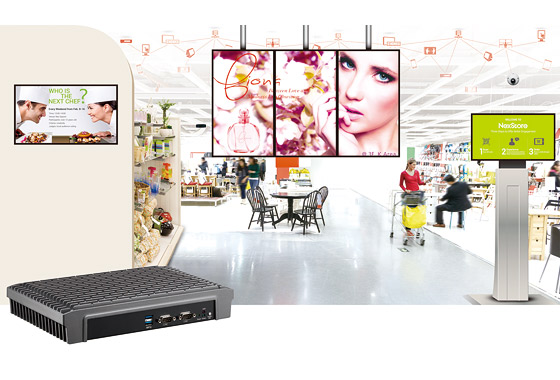NEXCOM Fuses Digital & Physical Retail with Responsive Store Solutions

With eCommerce capturing a booming share of sales, physical retailers are challenged but not doomed because they provide irreplaceable touch-and-feel experience for brick-and-mortar consumers. To reinvent shopping experience and rebuild brand values, many physical retailers are building "responsive stores" to merge the advantages of online and offline shops.
Responsive stores cover all aspects of shopping experience from entrance to exit. They can be divided into digital shopping carts, digital shelf management system, in-store intelligent video system, virtual fitting room, and experience centers.
Responsive Stores: Win-wins for Retailers & Customers
Digital shopping carts are computerized shopping carts with tablets. They provide personal shopping services such as style advice, product search, and wine recommendations. "If customers have questions, these carts can show detailed product information with augmented reality technologies or connect to customer service centers," said Steven Wu, GM of Multi-Media Solutions Business Unit, NEXCOM. In addition, they can automatically scan and check out items in carts, shortening customers' queue time.

Regarding digital shelf management system, Wu suggests that retailers can use electronic shelf labels to keep product information up to date and make minute-by-minute pricing changes based on price comparison information. Also, digital shelf management system can connect to enterprise resource planning software (ERP) and automatic replenish system. When shelves run low, products can be automatically restocked without interrupting customers, thus delivering a more comfortable environment.
Informative and Thorough Shopping Experience
Integrated with cameras and sensors, the in-store intelligent video system performs various features and interactive scenarios. For instance, the system collects customers' eye movement, traffic flow, and shopping behaviors for further analysis. With the system, retailers can identify hot shelf zones and eye-gazed product features for improved shelf layout and product design. Also, the system can greet visitors, identify customer groups, and deliver advertisements relevant to customers.
Virtual fitting rooms enable customers to try on clothes to check size and style virtually. Using such as 3D scanning, depth-sensing, and virtual reality, latest virtual fitting rooms can convert the 2D front view into unprecedented immersive 3D experiences, allowing customers to visualize how apparel would look on them in every direction. They can even upload these fitting photos for peer feedback via social network. This 360-degree perspective can also be applied to furniture stores and car dealers for previewing interior design.
Last but not least, retailers can remodel store layout to boost customer satisfaction by establishing service and experience centers between checkout counters and the exit. The digital-signage-enabled space can bring premium services and customer interactions to reinforce brand image and perform customer satisfaction analysis.
Integrates Bricks with Clicks
Recently, eCommerce brands are establishing physical stores and experience centers to strengthen competitiveness. In addition to providing a wide selection of products, abundant product information, and fast checkout, online shops still need the final piece of the puzzle to create physical interactions between customers and products and to enhance branding.
On the other hand, although online sales are fast gaining share of overall retail market, traditional retailers are fighting back. They are bringing eCommerce advantages into physical stores, seeking to close the gap between online and in-store experiences. Some retailers in Europe and North America are adopting emerging technologies to turn brinks and mortar into gold. This trend of change and innovation is accelerating across APAC retailers. The format of responsive stores continues evolving with technological advancement and customer-behavior changes. The future of retail stores relies on retailers and system providers together. With decades of experience with digital signage in retail and responsive store solutions, NEXCOM certainly plays key roles for retail innovation and renovation.
- Related Links:
- Urban PET Recycling Reinvented Sustainable Solutions Powered by NDiS B561
- The NDiS B562: Powering Precision in Edge AI and AOI Applications
- Browse Other News:
- Smarter Healthcare Self-Service Starts with Neu-XE102 & XE104 Edge Computing
- NEXCOM Brings Expanded Edge, Security, and Quantum-Resistant Innovations to MWC Barcelona 2026
- All White Papers News
